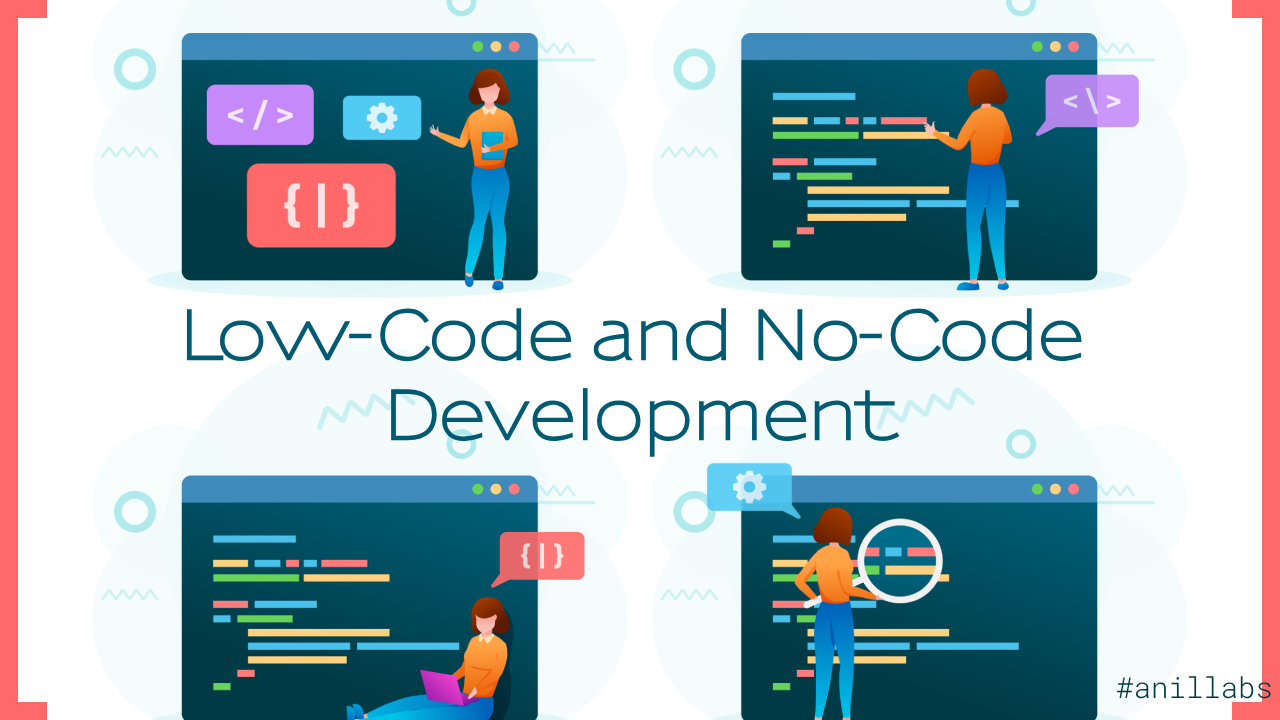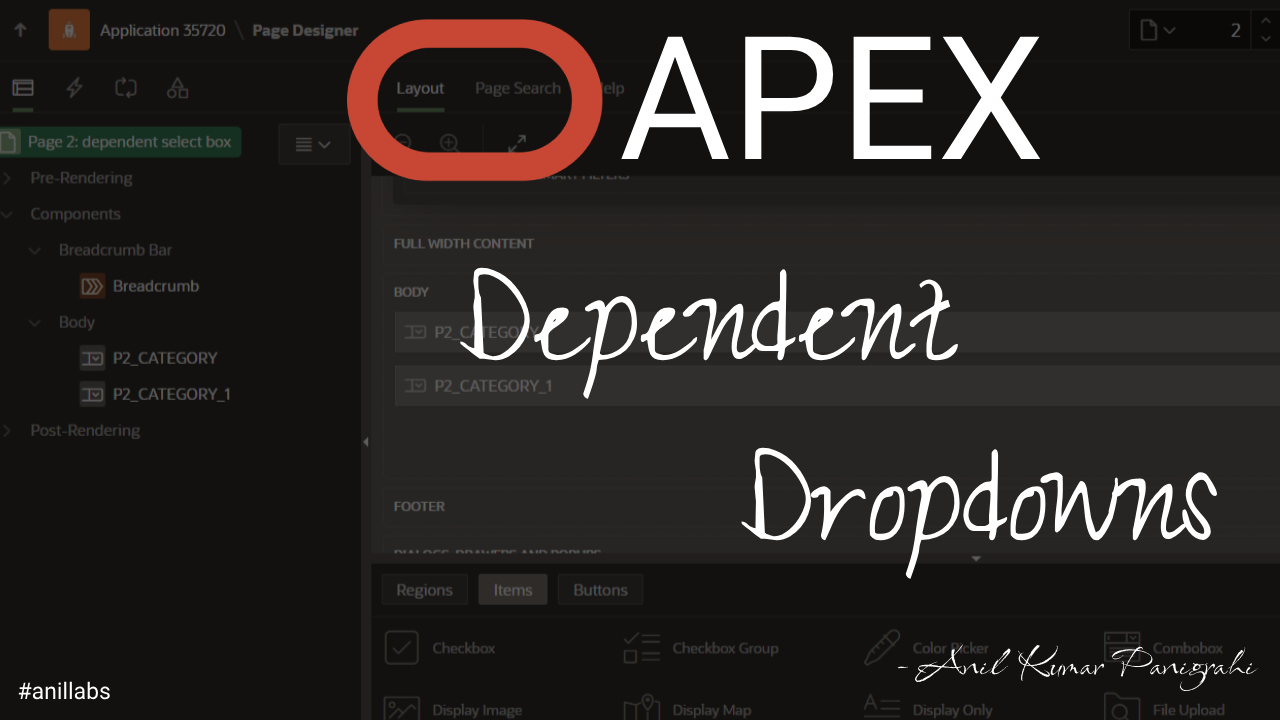In today’s fast-paced digital landscape, businesses of all sizes are constantly seeking innovative ways to stay ahead of the competition. One such approach that has gained significant traction is low-code and no-code development. These visual software development environments enable both professional developers and non-technical individuals, often referred to as citizen developers, to create mobile and web applications quickly and easily. In this comprehensive guide, we will explore the concept of low-code and no-code development, their benefits, limitations, and use cases.

The Power of Low-Code and No-Code Development: A Comprehensive Guide by Anil Labs
What is Low-Code Development?
Low-code development is a modern approach to software development that eliminates the need for extensive coding knowledge. Instead of writing lines of code from scratch, developers can use a graphical user interface (GUI) with drag-and-drop functionality to design and build applications. Low-code development platforms, also known as low-code application development platforms (LCAPs), provide a visual building experience that allows users to connect pre-built components and create complex workflows without the need for traditional coding.
The main advantage of low-code development is its ability to accelerate the application development process. With the automation, templates, and integrated development environments (IDEs) offered by low-code platforms, developers can build applications more quickly and efficiently compared to traditional coding methods. This allows them to focus on higher-value tasks and deliver applications faster.
What is No-Code Development?
No-code development takes the concept of low-code a step further by enabling individuals with no coding experience to build applications. No-code platforms provide a simplified interface, often using drag-and-drop functionality, that allows users to create applications without writing a single line of code. These platforms are designed to be user-friendly, making app development accessible to non-technical users such as business analysts, office administrators, and small business owners.
The key advantage of no-code development is its ability to democratize application development. It empowers individuals without technical backgrounds to take part in creating solutions tailored to their specific needs. This reduces the reliance on IT departments or external developers, allowing organizations to address their unique challenges more efficiently.
Low-Code vs. No-Code: Understanding the Differences
While low-code and no-code development share similar goals of simplifying the application development process, there are some key differences between the two approaches.
Low-Code Development
Low-code development requires some level of coding knowledge, although significantly less than traditional coding methods. Professional developers and programmers can leverage low-code tools to quickly deliver applications by building on pre-existing components and templates. This approach allows them to shift their focus from mundane programming tasks to more complex and impactful work.
Low-code development is also suitable for non-technical users with basic programming knowledge. They can use low-code tools to develop simple applications or enhance existing ones with additional features. Low-code platforms offer flexibility, allowing users to choose between codeless customization and writing custom code based on their specific needs. This makes low-code development a versatile solution for a wide range of projects.
No-Code Development
No-code development is geared towards individuals without any coding experience. It enables non-technical users to create applications using intuitive interfaces and visual building blocks. With no-code platforms, users can design and build applications without the need for traditional programming languages or technical skills.
No-code development is particularly suitable for businesses that want to empower their non-technical employees to build simple applications or automate manual processes. It allows business users to take ownership of their app development needs, reducing the reliance on IT departments or external developers. However, the customization options in no-code development may be more limited compared to low-code, as users are confined to pre-built templates and components.
The Benefits of Low-Code and No-Code Development
Both low-code and no-code development offer a range of benefits that make them attractive options for businesses. Let’s explore some of the key advantages of these approaches:
Accelerated Development Process
One of the most significant advantages of low-code and no-code development is the speed at which applications can be built. With visual interfaces, pre-built components, and drag-and-drop functionality, developers can create applications more quickly and efficiently than with traditional coding methods. This accelerated development process allows businesses to bring their ideas to fruition faster, reducing time-to-market and enabling them to stay ahead of the competition.
Increased Productivity
Low-code and no-code platforms streamline the app development process, ultimately increasing developer productivity. By eliminating the need to write code line by line, developers can focus on higher-value tasks and complex problem-solving. This allows them to deliver applications more efficiently and frees up their time for more strategic initiatives.
For non-technical users, low-code and no-code development provide the opportunity to take ownership of their app development needs. This empowers business users to create applications tailored to their specific requirements without relying on IT departments or external developers. It increases their productivity and efficiency in addressing their own challenges.
Cost Savings
Low-code and no-code development can result in significant cost savings for businesses. By leveraging existing staff, including citizen developers, organizations can reduce the need to hire additional developers or outsource development work. This not only saves on recruitment and outsourcing costs but also enables businesses to allocate their resources more effectively.
Furthermore, low-code and no-code platforms often offer affordable pricing options, making them accessible to businesses of all sizes. Some platforms even provide free or low-cost plans, allowing businesses to experiment and explore app development without a significant financial investment.
Flexibility and Customization
Low-code and no-code development platforms provide flexibility and customization options to meet specific business requirements. With visual interfaces and drag-and-drop functionality, users can easily customize applications to align with their unique needs and preferences. This level of customization allows businesses to create tailor-made solutions that address their specific challenges and workflows.
Additionally, low-code and no-code development platforms enable businesses to iterate and make changes to their applications quickly. With the ability to modify components and workflows visually, developers can respond to feedback and adapt applications to evolving business needs more efficiently than with traditional coding methods.
Empowering Citizen Developers
One of the key advantages of low-code and no-code development is the ability to empower citizen developers. Citizen developers are non-technical individuals within an organization who have a deep understanding of the business and its processes. Low-code and no-code platforms enable these individuals to take an active role in app development, allowing them to build applications that directly address their unique challenges and requirements.
By empowering citizen developers, organizations can tap into a wider pool of talent and expertise. This distributed approach to app development fosters innovation and collaboration, as individuals from different departments can contribute their ideas and knowledge to create impactful applications.
Supporting Digital Transformation
In today’s digital era, businesses must embrace digital transformation to stay competitive. Low-code and no-code development plays a crucial role in this transformation process. By enabling faster and more efficient app development, businesses can accelerate their digital initiatives and meet the ever-increasing demands of customers and users.
Low-code and no-code platforms provide the flexibility and agility required to support digital transformation efforts. They allow organizations to quickly prototype, test, and iterate on new ideas, enabling faster innovation and adaptation in a rapidly changing business landscape.
Challenges and Limitations of Low-Code and No-Code Development
While low-code and no-code development offer numerous benefits, it’s essential to understand the challenges and limitations associated with these approaches. Here are some key considerations:
Complexity of Applications
While low-code and no-code platforms excel at simplifying the development process, they may not be suitable for building highly complex applications. Applications with intricate logic, extensive integrations, or advanced functionality may require more specialized coding knowledge and expertise. In such cases, a hybrid approach that combines low-code or no-code development with traditional coding methods may be necessary.
Security and Governance
Security can be a concern when using low-code and no-code platforms. As these platforms provide easy-to-use interfaces and pre-built components, there is a risk of overlooking security best practices. Organizations must establish proper security and governance protocols to ensure the protection of sensitive data and prevent unauthorized access.
Additionally, organizations should carefully evaluate the security features and compliance certifications offered by low-code and no-code platforms before selecting one. Choosing a platform with robust security measures and a strong track record in data protection is crucial.
Customization Limitations
While low-code and no-code platforms offer customization options, there may be limitations to the extent of customization possible. Users are often confined to pre-built templates, components, and workflows provided by the platform. This can restrict the ability to create highly unique or specialized applications.
Organizations should consider their specific customization requirements and evaluate whether the available options within a low-code or no-code platform align with their needs. In some cases, a more traditional coding approach may be necessary to achieve the desired level of customization.
While low-code and no-code platforms aim to simplify app development, there is still a learning curve involved, especially for individuals without technical backgrounds. Users need to familiarize themselves with the platform’s interface, features, and best practices to make the most of the development process.
Organizations should invest in proper training and resources to support their teams in learning and mastering the low-code or no-code development tools. This will ensure that users can leverage the full potential of the platform and build high-quality applications.
Low-code and no-code development platforms can be used to create a wide range of applications to address various business needs. Here are some common use cases for these approaches:
Rapid Application Development
Low-code and no-code platforms are ideal for rapid application development, allowing businesses to quickly prototype and test their ideas. These platforms enable users to build functional applications with minimal coding, reducing the time and effort typically required for traditional development.
Process Automation and Workflow Optimization
Organizations can use low-code and no-code platforms to automate manual processes and optimize workflows. By creating customized applications tailored to specific business processes, businesses can streamline operations, reduce errors, and improve efficiency.
Customer Experience Applications
Low-code and no-code platforms are well-suited for building customer experience applications. These applications can include self-service portals, mobile apps, and interactive interfaces that enhance the overall customer experience. By leveraging low-code and no-code development, businesses can quickly develop and deploy customer-centric applications.
Employee Productivity and Collaboration
Low-code and no-code platforms can also be used to develop applications that improve employee productivity and collaboration. These applications can include project management tools, communication platforms, and document management systems. By empowering employees with customized applications, businesses can enhance productivity and foster collaboration within their teams.
Legacy System Modernization
Organizations with legacy systems can leverage low-code and no-code development to modernize their applications. By building new applications or integrating existing systems with low-code or no-code platforms, businesses can extend the lifespan of their legacy systems and enhance their functionality.
Major Low-Code and No-Code Development Platforms
The market for low-code and no-code development platforms is rapidly expanding, with numerous vendors offering robust solutions. Here are some of the major platforms available:
| Platform | Description |
|---|---|
| Appian | Appian is a low-code platform that enables organizations to build and deploy enterprise-grade applications quickly and easily. It offers a visual development environment and a wide range of pre-built components and integrations. |
| OutSystems | OutSystems is a low-code platform that allows organizations to build, deploy, and manage applications at scale. It provides a visual development environment, AI-assisted development, and a wide range of pre-built templates and connectors. |
| Microsoft Power Apps | Microsoft Power Apps is a low-code platform that empowers organizations to create custom applications and automate business processes. It integrates seamlessly with other Microsoft products and offers a user-friendly interface with drag-and-drop functionality. |
| Mendix | Mendix is a low-code platform that enables organizations to build and deploy applications quickly and collaboratively. It offers a visual development environment, AI-assisted development, and a wide range of pre-built components and connectors. |
| Bubble | Bubble is a no-code platform that allows individuals to build web and mobile applications without coding. It offers a visual interface with drag-and-drop functionality and integrates with various third-party services and APIs. |
| Adalo | Adalo is a no-code platform that allows users to create mobile apps without coding. It offers a visual development environment, pre-built components, and integrations with popular services. |
| Appgyver | Appgyver is a no-code platform that enables users to build web and mobile applications with a visual development environment. It offers drag-and-drop functionality, pre-built templates, and integrations with various databases and APIs. |
| Glide | Glide is a no-code platform that allows users to create mobile apps from spreadsheets without coding. It offers a visual interface and integrates with Google Sheets to generate apps based on spreadsheet data. |
| Webflow | Webflow is a no-code platform that enables users to build responsive websites and web applications visually. It offers a drag-and-drop interface, pre-designed templates, and the ability to customize code for advanced users. |
The Future of Low-Code and No-Code Development
The low-code and no-code development market is expected to continue growing in the coming years. As businesses increasingly prioritize digital transformation and seek ways to accelerate app development, the demand for low-code and no-code platforms will continue to rise. Analysts project significant growth in the market, with low-code application development expected to account for a significant portion of all application development activity.
However, it is important to note that low-code and no-code development will not replace traditional coding entirely. While these approaches offer many benefits, there will still be situations that require more complex coding and specialized expertise. It is crucial for organizations to evaluate their specific needs and determine the most appropriate approach for each project.
Conclusion
Low-code and no-code development have revolutionized the way businesses build applications. These approaches provide an accessible and efficient way for both professional developers and non-technical individuals to create web and mobile apps. With their ability to accelerate development, increase productivity, reduce costs, and empower citizen developers, low-code and no-code platforms have become integral tools for businesses across industries.
By leveraging low-code and no-code development, organizations can embrace digital transformation, enhance customer experiences, optimize workflows, and modernize legacy systems. While there are challenges and limitations to consider, the benefits of low-code and no-code development outweigh the drawbacks for many businesses.
As the market continues to evolve, it is crucial for organizations to stay informed about the latest low-code and no-code platforms and choose the ones that best align with their specific needs and goals. By embracing the power of low-code and no-code development, businesses can drive innovation, accelerate app delivery, and achieve their digital transformation objectives.








0 Comments